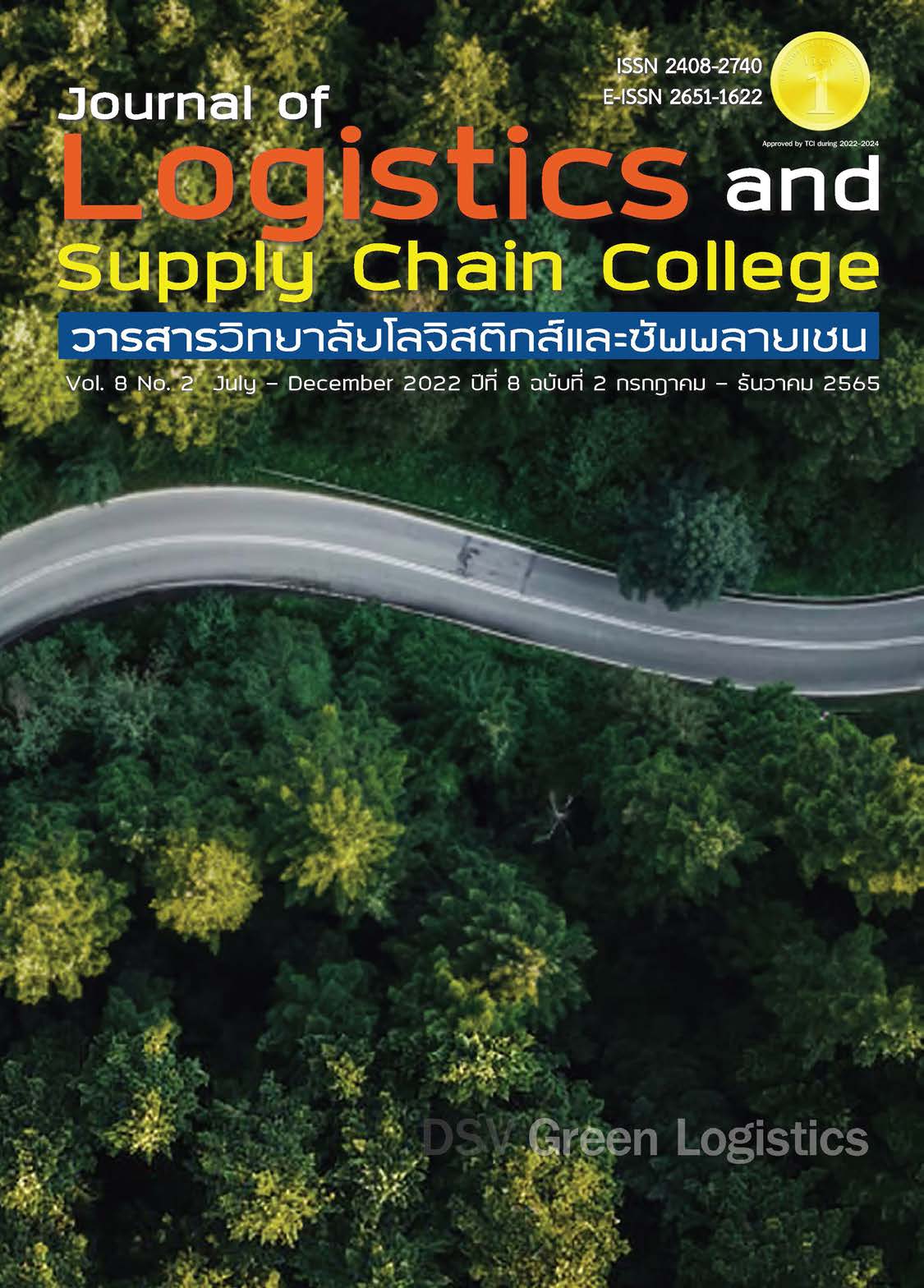Logistics and Supply Chain Competency Affecting Air Freight Operation of Thai Airways International Public Company Limited
Keywords:
Competency, Logistics, Supply chain, Air freight operationAbstract
The objectives of this research were to 1) study the logistics and supply competency level of Thai Airways International Public Company Limited, and 2) to study the logistics and supply chain competency affecting the air freight operation of Thai Airways International Public Company Limited. The research instrument was a set of questionnaires with index of item objective congruence (IOC) of 0.86 and with a reliability of 0.97. The sample was 316 people using the proportional sampling method. The statistics were percentage, frequency, mean, standard deviation, and multiple regression equations. The research results found that (1) the overall logistics competency was high (4.23), with international safety transport was the highest (4.33), followed by punctuality (4.25), customs clearance (4.24), checking transport situation (4.23), international transportation (4.19), and infrastructure (4.16), the overall supply chain competency was at the high (4.22), with flexibility was at the highest (4.33), followed by reliability (4.24), responsibility (4.22), asset management (4.19), and supply chain cost (4.11). (2) The logistics and supply chain competency affecting the air freight operation of Thai Airways International Public Company Limited was statistically significant at .01.
References
กัลยา วานิชย์บัญชา. (2559). การวิเคราะห์สถิติ สถิติสำหรับบริหารและวิจัย. พิมพ์ครั้งที่ 16. กรุงเทพฯ: จุฬาลงกรณ์มหาวิทยาลัย.
วิจัยกรุงศรี. (2564). แนวโน้มธุรกิจ/อุตสาหกรรมปี 2564-2566: บริการขนส่งทางอากาศ. ค้นเมื่อ 5 มีนาคม 2564, จาก: https://www.krungsri.com/th/research/industry/industry-outlook/logistics/air-transport/IO/io-Air-Transport-21.
ชิตพงษ์ อัยสานนท์. (2562). การฟื้นฟูบริการในการขนส่งสินค้าทางอากาศสมรรถนะของโซ่อุปทานและผลการ ดำเนินงานในธุรกิจส่งออก. วารสารเกษมบัณฑิต, 20(พิเศษ), 101-116.
เทอดศักดิ์ บุญทศ. (2561). ปัจจัยที่มีอิทธิพลต่อประสิทธิผลในการบริหารจัดการโลจิสติกส์: ศึกษากรณีเขตเศรษฐกิจพิเศษมุกดาหาร. วารสารวิชาการ มหาวิทยาลัยปทุมธานี, 10(1), 295-300.
บริษัท การบินไทย จำกัด (มหาชน). (2563). รายงานประจำปี พ.ศ. 2563 บริษัท การบินไทย จำกัด (มหาชน).
ภัทรวิทย์ ทองฉิม. (2555). ความสัมพันธ์ระหว่างการจัดการโซ่อุปทานและการวัดสมรรถนะโซ่อุปทานยางพารา. วารสารการจัดการ มหาวิทยาลัยวลัยลักษณ์, 10(1), 58-66.
วันพิชิตต์ อรรคดี และศักดิ์สินี กลิ่นสุนทร. (2560). ปัจจัยที่สำคัญต่อการเลือกใช้บริการขนส่งของบริษัท ยูเซ็น โลจิสติกส์ (ประเทศไทย) จํากัด. การค้นคว้าอิสระบริหารธุรกิจมหาบัณฑิต, วิทยาลัยเซาธ์อีสท์บางกอก.
ศุภางค์ นันตา. (2555). ผลกระทบของกลยุทธ์นวัตกรรมบริการที่มีต่อผลการดำเนินงานของธุรกิจสปา ในประเทศไทย. วิทยานิพนธ์ปริญญาปรัชญาดุษฎีบัณฑิต, มหาวิทยาลัยมหาสารคาม.
สำนักโลจิสติกส์ กรมอุตสาหกรรมพื้นฐานและการเหมืองแร่. (2559). ตัวชี้วัดประสิทธิภาพด้านโลจิสติกส์ของสถานประกอบการภาคอุตสาหกรรม คืออะไร. ค้นเมื่อ 26 ตุลาคม 2564, จาก: https://www.logisticafe.com/2016/05/industrial-logistics-performance-index-ilpi-A3/.
อมรา ดอกไม้ และศุภลักษณ์ ศรีวิไลย. (2563). แนวทางการเพิ่มประสิทธิภาพการส่งออกสินค้าทางอากาศ. วารสารวิทยาการจัดการปริทัศน์, 22(1), 233-240.
Barone, A., Murphy, P., Wardlow, D., & Wood, D. (2002). International logistics. New York: Amacom.
Chopra, S. & Meindl, P. (2016). Supply Chain Management: Strategy, Planning and Operation. (6th edition). Essex, NE., Pearson Education.
Gunasekaran, A., Patel, C., & Tirtiroglu, E. (2001). Performance measures and metrics in a supply chain environment. International journal of operations and production management, 21(1/2), 1-78.
Handfield, R.B. & Nicholas Jr., E.L. (2002). Supply Chain Redesign: Converting Your Supply Chain into Integrated Value Systems. Financial Times, Englewood Cliffs. NJ: Prentice-Hall.
Jadesadalug, V. & Ussahawanitchakit, P. (2009). Building Innovative Creation Efficiency of Furniture Business in Thailand: An Empirical Research of its Antecedents and Consequences. International Journal of Strategic Management, 9(3), 36-58.
Lankford, W.M. (2004). Supply Chain Management and the Internet. Emerald insight, 28(4), 301-305. www.emeraldinsight.com/1468-4527.htm.
Little, E., & Marandi, E. (2003). Relationship marketing management. London: Thomson Learning.
Li, X., Cassidy, J. J., Reinke, C. A., Fischboeck, S., & Carthew, R. W. (2009). A micro-RNA imparts robustness against environmental fluctuation during development. Cell Press, 137(2), 273-282.
Millet, J. D. (1954). Management in the Public Service. New York: McGraw Hill.
Rauch, A., Wiklund, J., Lumpkin, G., & Frese, M. (2009). Entrepreneurial Orientation and Business Performance: An Assessment of Past Research and Suggestions for the Future. Entrepreneurship Theory and Practice, 33(3), 761-787.
Simchi-Levi, D., Kaminsky, P., & Simchi-Levi, E. (2004). Managing the Supply Chain: The Definitive Guide for the Business Professional. (1st ed.). New York: McGraw-Hill.
Stuart-Kotze, R. (2006). Performance: The Secrets of Successful Behavior. Great Britain, Pearson Education.
Supply Chain Council, Inc. (2003). Supply Chain Operations Reference Overview of SCOR version 6.0. Pittsburgh, PA: Supply Chain Council.
Van Asch, T., Dewulf, W., Kupfer, F., Meersman, H., Onghena, E. & Van de Voorde, E. (2019). Air Cargo and Airport Competitiveness. Journal of Air Transport Studies, 10(2), 48-75.
Walter, A., Auer, M. & Ritter, T. (2006). The Impact of Network Capabilities and Entrepreneurial Orientation on University Spin-off Performance. Journal of Business Venturing, 21(4), 541-567.
World Bank. (2017). Logistics Performance Index Report. Retrieved 26 October 2021, From: https://www.nesdb.go.th/ewt_dl_link.php?nid=8143&filename=index.
Yamane, T. (1973). Statistics: An Introductory Analysis. (3rd ed.). New York: Harper and. Row Publication.



